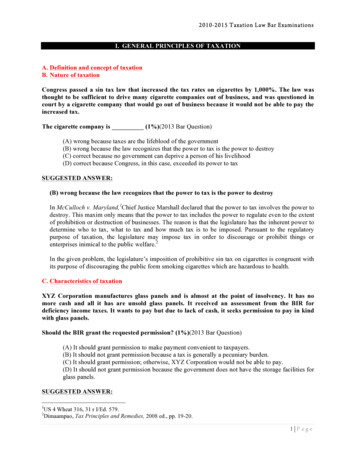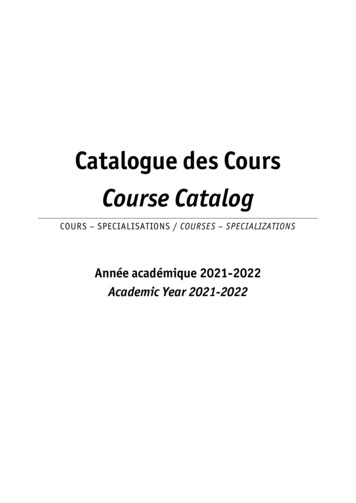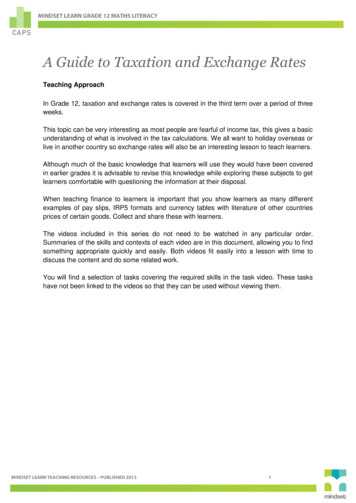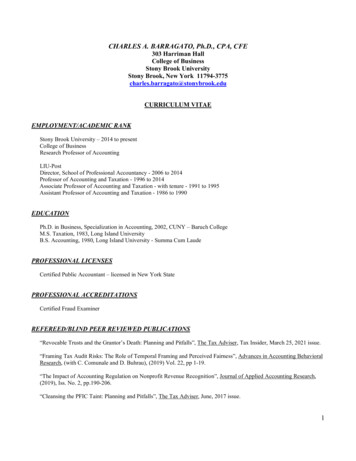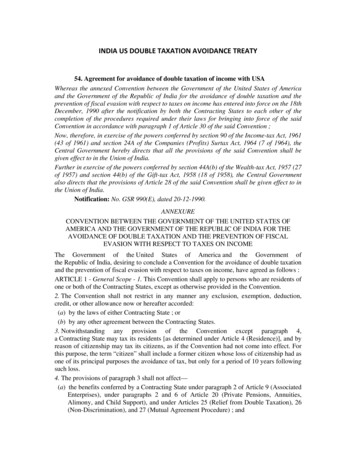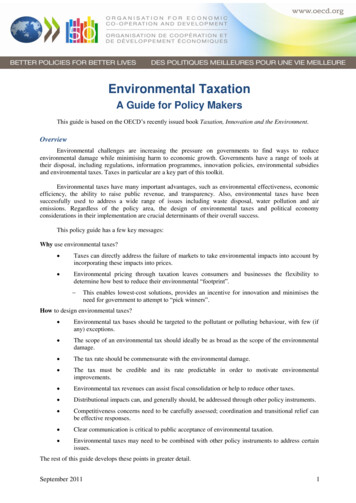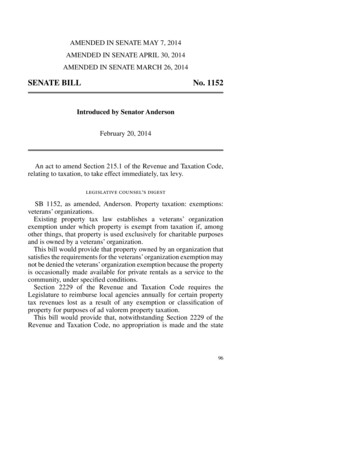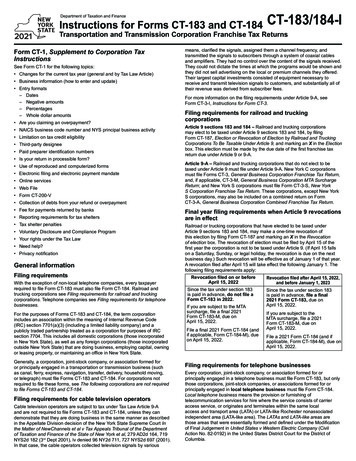
Transcription
Department of Taxation and FinanceInstructions for Forms CT-183 and CT-184CT-183/184-ITransportation and Transmission Corporation Franchise Tax ReturnsForm CT-1, Supplement to Corporation TaxInstructionsSee Form CT-1 for the following topics: Changes for the current tax year (general and by Tax Law Article) Business information (how to enter and update) Entry formats– Dates– Negative amounts– Percentages– Whole dollar amounts Are you claiming an overpayment? NAICS business code number and NYS principal business activity Limitation on tax credit eligibility Third-party designee Paid preparer identification numbers Is your return in processible form? Use of reproduced and computerized forms Electronic filing and electronic payment mandate Online services Web File Form CT-200-V Collection of debts from your refund or overpayment Fee for payments returned by banks Reporting requirements for tax shelters Tax shelter penalties Voluntary Disclosure and Compliance Program Your rights under the Tax Law Need help? Privacy notificationGeneral informationFiling requirementsWith the exception of non-local telephone companies, every taxpayerrequired to file Form CT-183 must also file Form CT-184. Railroad andtrucking corporations see Filing requirements for railroad and truckingcorporations. Telephone companies see Filing requirements for telephonebusinesses.For the purposes of Forms CT-183 and CT-184, the term corporationincludes an association within the meaning of Internal Revenue Code(IRC) section 7701(a)(3) (including a limited liability company) and apublicly traded partnership treated as a corporation for purposes of IRCsection 7704. This includes all domestic corporations (those incorporatedin New York State), as well as any foreign corporations (those incorporatedoutside New York State) that are doing business, employing capital, owningor leasing property, or maintaining an office in New York State.Generally, a corporation, joint-stock company, or association formed foror principally engaged in a transportation or transmission business (suchas canal, ferry, express, navigation, transfer, delivery, household moving,or telegraph) must file Forms CT-183 and CT-184. For corporations notrequired to file these forms, see The following corporations are not requiredto file Forms CT-183 and CT-184.Filing requirements for cable television operatorsCable television operators are subject to tax under Tax Law Article 9-Aand are not required to file Forms CT-183 and CT-184, unless they candemonstrate that they are doing business in the same manner as describedin the Appellate Division decision of the New York State Supreme Court Inthe Matter of NewChannels et al v Tax Appeals Tribunal of the Departmentof Taxation and Finance of the State of New York et al, 279 AD2d 164, 719NYS2d 182 (3rd Dept 2001), lv denied 96 NY2d 711, 727 NYS2d 697 (2001).In that case, the cable operators collected television signals by variousmeans, clarified the signals, assigned them a channel frequency, andtransmitted the signals to subscribers through a system of coaxial cablesand amplifiers. They had no control over the content of the signals received.They could not dictate the times at which the programs would be shown andthey did not sell advertising on the local or premium channels they offered.Their largest capital investments consisted of equipment necessary toreceive and transmit television signals to customers, and substantially all oftheir revenue was derived from subscriber fees.For more information on the filing requirements under Article 9‑A, seeForm CT‑3‑I, Instructions for Form CT‑3.Filing requirements for railroad and truckingcorporationsArticle 9 sections 183 and 184 – Railroad and trucking corporationsmay elect to be taxed under Article 9 sections 183 and 184, by filingForm CT-187, Election or Revocation of Election by Railroad and TruckingCorporations To Be Taxable Under Article 9, and marking an X in the Electionbox. This election must be made by the due date of the first franchise taxreturn due under Article 9 or 9-A.Article 9-A – Railroad and trucking corporations that do not elect to betaxed under Article 9 must file under Article 9-A. New York C corporationsmust file Forms CT-3, General Business Corporation Franchise Tax Return,and, if applicable, CT-3-M, General Business Corporation MTA SurchargeReturn; and New York S corporations must file Form CT-3-S, New YorkS Corporation Franchise Tax Return. These corporations, except New YorkS corporations, may also be included on a combined return on FormCT‑3-A, General Business Corporation Combined Franchise Tax Return.Final year filing requirements when Article 9 revocationsare in effectRailroad or trucking corporations that have elected to be taxed underArticle 9 sections 183 and 184, may make a one-time revocation ofthis election by filing Form CT-187 and marking an X in the Revocationof election box. The revocation of election must be filed by April 15 of thefirst year the corporation is not to be taxed under Article 9. (If April 15 fallson a Saturday, Sunday, or legal holiday, the revocation is due on the nextbusiness day.) Such revocation will be effective as of January 1 of that year.A revocation filed after April 15 will take effect the following January 1. Thefollowing filing requirements apply:Revocation filed on or beforeApril 15, 2022Since the tax under section 183is paid in advance, do not file aForm CT-183 in 2022.If you are subject to the MTAsurcharge, file a final 2021Form CT‑183‑M, due onApril 15, 2022.File a final 2021 Form CT-184 (andif applicable, Form CT-184-M), dueon April 15, 2022.Revocation filed after April 15, 2022,and before January 1, 2023Since the tax under section 183is paid in advance, file a final2021 Form CT‑183, due onApril 15, 2022.If you are subject to theMTA surcharge, file a 2021Form CT‑183‑M, due onApril 15, 2022.File a 2021 Form CT‑184 (and ifapplicable, Form CT‑184‑M), due onApril 15, 2022.Filing requirements for telephone businessesEvery corporation, joint-stock company, or association formed for orprincipally engaged in a telephone business must file Form CT-183, but onlythose corporations, joint-stock companies, or associations formed for orprincipally engaged in local telephone business must file Form CT‑184.Local telephone business means the provision or furnishing oftelecommunication services for hire where the service consists of carrieraccess service, or originates and terminates within the same localaccess and transport area (LATA) or LATA-like Rochester nonassociatedindependent area (LATA-like area). The LATAs and LATA-like areas arethose areas that were essentially formed and defined under the Modificationof Final Judgement in United States v Western Electric Company (CivilAction No. 82-0192) in the United States District Court for the District ofColumbia.
Page 2 of 7CT-183/184-I (2021)Telecommunication services means telephony or telegraphy or anytelephone or telegraph service including, but not limited to, any transmissionof the following: voice, image, data, information, and paging, through theuse of wire, cable, fiber-optic, laser, microwave, radio wave, satellite, orsimilar media, or any combination thereof.Telecommunication services also includes services that are nottelecommunication services as such, but are: (1) ancillary to the provisionof telephone service (for example, directory information, call forwarding,caller identification, call waiting, and supplementary services); and (2) services(of whatever nature) that are provided with telecommunication services. Thereceipts from equipment provided in connection with any telecommunicationservice (for example, equipment such as beepers, telephones, faxmachines, and modems) are also subject to tax under section 184.Telecommunication services does not include separately stated charges fora service that alters the substantive (information) content of the messagereceived from that sent.Telecommunication services excludes television or radio programmingtransmitted to subscribers by cable television service.All telecommunication providers, whether organized in the corporate orindividual form (including local telephone service providers) are subjectto the excise tax under Tax Law, Article 9, section 186-e, Excise Tax onTelecommunication Services. Certain telecommunication providers mayalso be subject to tax under Article 9 section 186-a on receipts from salesof water, gas, electricity, steam, or refrigeration. For more details, seeForm CT-186-E-I, Instructions for Form CT-186-E.The following corporations are not required to fileForms CT-183 and CT-184: Foreign taxicab and omnibus corporations that conduct fewer than 12trips into New York State during the calendar year are not taxable underArticle 9 if they do not otherwise own or lease property, or maintain anoffice in New York State. Corporations exclusively engaged in the operation of vessels in foreigncommerce are exempt from all state and local taxation on their capitalstock, franchises, and earnings. Ferry companies that operate between any of the boroughs of the cityof New York under a lease granted by New York City are exempt from taxation. Aviation corporations (including air freight forwarders acting as principaland like indirect air carriers) are subject to tax under Article 9-A andmust file Form CT-3 or, if in a combined group, Form CT-3-A. SeeTSB-M-89(10)C, Taxability of Aviation Corporations under Article 9-A. Any corporation that is an organization defined by Tax Lawsection 186‑e.2(b)(3) and that is principally engaged in providingtelecommunication services for the purpose of air safety and navigation,is not subject to tax under section 184. Corporations principally engaged in the transportation, transmission,or distribution of gas, electricity, or steam are not subject to tax undersections 183 and 184.Use Form CT-183 to report and pay the franchise tax required by Article 9section 183. This is an annual tax based on the corporation’s allocatedcapital stock, or a minimum tax of 75.Use Form CT-184 to report and pay the franchise tax required by Article 9section 184. This tax is based on the corporation’s gross earnings from allNew York State sources.Taxpayers subject to tax under Tax Law sections 183 and 184 must file bothForms CT-183 and CT-184 yearly. Unless excluded above, taxpayers whodo not have taxable gross earnings must still file Form CT-184 to show thatno tax is due under Tax Law, Article 9, section 184.When and where to fileThe filing period for both forms must be based on a calendar year,regardless of your federal reporting period. This return is due on April 15,following the close of the tax year. If April 15 falls on a Saturday, Sunday, orlegal holiday, the return is due on the next business day. Mail to:NYS CORPORATION TAXPO BOX 15181ALBANY NY 12212-5181General informationPrivate delivery services – See Publication 55, Designated PrivateDelivery Services.Extension of time for filing tax returnIf you wish to extend the filing deadline, you may request a three-monthextension by filing Form CT-5.9, Request For Three‑Month Extension ToFile, on or before the original due date. An extension of time granted bythe Internal Revenue Service (IRS) to file a federal return does not extendthe date for filing a New York State return. You may make a request for anadditional three‑month extension of time by filing Form CT‑5.1, Request ForAdditional Extension of Time To File.Tax basisTax Law, Article 9, section 183, provides for a franchise tax based onthe net value of issued capital stock employed in New York State (seeForm CT‑183, Schedule D).The net value of issued capital stock may be allocated within and outsideNew York State. Base the allocation on the gross assets employed inNew York State (see Form CT-183, Schedule A).The franchise tax required by section 183 is the highest of the three taxescomputed by the following three methods:1. Allocated value of issued capital stock multiplied by the tax rate of1.5 mills (.0015).2. Allocated value of issued capital stock on which dividends are paid at arate of 6% or more, multiplied by the tax rate of .375 mills (.000375) foreach 1% of dividends paid. Apply a rate of 1.5 mills (.0015) to capitalstock on which dividends are not paid, or are paid at a rate of less than6%.3. Minimum tax of 75.A combination of tax on capital stock using the tax rate of 1.5 mills and thedividend rate as computed in Schedule E is possible if a corporation hasmore than one kind of stock (see Form CT-183).Tax Law, Article 9, section 184, provides for a tax at the rate of ⅜%(.00375) of the gross earnings received from business conducted inNew York State during the tax year (see Form CT-184).A railroad not operated by steam, whose property is leased to anotherrailroad, shall pay only a tax of 4.5% on dividends paid during the tax yearthat are in excess of 4% of the amount of its capital stock. The tax on grossearnings would not apply.The tax under Article 9 section 184 does not apply to a foreign railroad,palace car, or sleeping car company, or to a navigation, canal, ferry,steamboat, or other corporation operating vessels if the corporation’s onlyactivities in New York State are (1) maintaining an office and employingcapital, and (2) owning property used exclusively in interstate or foreigncommerce.Penalty for underpaying estimated tax – Article 9section 184If you can reasonably expect your New York State franchise tax liabilityunder Article 9 section 184 to exceed 1,000, you must file a declaration ofestimated tax on Form CT-400, Estimated Tax for Corporations. We mayimpose a penalty if you fail to file a declaration of estimated tax or fail to paythe entire installment payment of estimated tax due. For more information,see Form CT-222-I, Instructions for Form CT-222.Late payment – InterestIf you do not pay the tax on or before the original due date (without regardto any extension of time for filing), you must pay interest on the amount ofthe underpayment from the original due date of the return to the date the taxis paid. Exclude from the interest computation any amount timely paid.Late filing and late payment – Additional chargesCompute additional charges for late filing and late payment on the amountof tax, minus any payment made on or before the due date (with regard toany extension of time for filing). Exclude from the penalty computation anyamount timely paid.A. If you do not file a return when due, or if your request for extensionis invalid, add to the tax 5% (.05) per month up to 25% (.25)(Article 27 section 1085(a)(1)(A)).
General informationB. If you do not file a return within 60 days of the due date, the addition totax in item A above cannot be less than the smaller of 100 or 100% ofthe amount required to be shown as tax (section 1085(a)(1)(B)).C. If you do not pay the tax shown on a return, add to the tax ½% (.005) permonth up to 25% (.25) (section 1085(a)(2)).D. The total of the additional charges in items A and C above may notexceed 5% (.05) for any one month, except as provided for in item Babove (section 1085(a)).If you think you are not liable for these additional charges, attach astatement to your return explaining the delay in filing, payment, or both(section 1085).Note: You may compute your penalty and interest by accessing ourwebsite, or you may call and we will compute the penalty and interest foryou (see Need help? in Form CT-1).Final returnMark an X in the Final return box on page 1 of the return, under the formnumber, only if filing a final tax return for one of the following reasons:CT-183/184-I (2021)Page 3 of 7An amended New York State return requesting a credit or refund must befiled within three years of the time the original return was filed or within twoyears of the time the tax was paid, whichever is later; or, if no return wasfiled, within two years of the time the tax was paid. For additional limitationson credits or refunds, see Tax Law, Article 27, section 1087.Employer identification number, file number, and other identifyinginformation – For us to process your corporation tax forms it is importantthat we have the necessary identifying information including your currentaddress. Keep a record of that information and include it on eachcorporation tax form mailed.If you use a paid preparer or accounting firm, make sure they use yourcomplete and accurate identifying information when completing all forms.Signature – The return must be certified by the president, vice president,treasurer, assistant treasurer, chief accounting officer, or other officerauthorized by the taxpayer corporation.The return of an association, publicly traded partnership, or businessconducted by a trustee or trustees must be signed by a person authorized toact for the association, publicly traded partnership, or business. surrender of authority by a foreign corporation (New York BusinessCorporation Law, section 1310);If an outside individual or firm prepared the return, all applicable entriesin the paid preparer section must be completed, including identificationnumbers (see Paid preparer identification numbers in Form CT-1). Failureto sign the return will delay the processing of any refunds and may result inpenalties. merger or consolidation (New York Business Corporation Law,sections 904, 904-a, 905, and 907);Instructions for Form CT-183 voluntary dissolution of a New York corporation (New York BusinessCorporation Law, section 1001-1003); disposition of assets of a New York corporation (New York BusinessCorporation Law, section 909(d)); termination of existence of a foreign corporation (New York BusinessCorporation Law, section 1311); or liquidation under IRC sections 332, 334, and 337.See Voluntary dissolution and surrender of authority and liability for taxesand fees for the proper procedures to follow in terminating your business.In the case of a merger or consolidation, only the non-surviving corporationmarks the Final return box.The return will be treated as a final return if your business is terminated withthe Department of State, and the return covers the tax period from the lastreturn filed to the date of termination.Do not mark the Final return box if you are only changing the type ofreturn that you file (for example, changing from Forms CT-183 and CT-184to Form CT‑3).If you have terminated business since March 2021, do not file a finalForm CT-183. The tax under section 183 is paid in advance.Voluntary dissolution and surrender of authority andliability for taxes and feesA domestic corporation (incorporated in New York State) is generally liablefor corporate franchise taxes for each fiscal or calendar year, or part thereof,during which it is incorporated, regardless of whether it carries on anyactivity. For example, a person who intends to go into business organizesa new corporation under the New York Business Corporation Law for thepurpose of operating the new business as a corporation. However, thebusiness is never started and the corporation never conducts any business.Under such circumstances, the corporation would usually be liable forfranchise taxes for each tax year until it is formally dissolved with theDepartment of State.A foreign corporation (incorporated outside New York State) is liable forfranchise taxes during the period in which it does business, employs capital,owns or leases property, or maintains an office in New York State.For information on voluntary dissolution and surrender of authority, seeInstructions for voluntary dissolution of a New York corporation (TR-125),and Instructions for surrender of authority by foreign business corporation(TR-199), on our website (see Need help? in Form CT-1).Completing your tax returnAmended return – If you are filing an amended return, mark an X in theAmended return box on the top of page 1.Metropolitan transportation business tax (MTA surcharge) – Anycorporation taxable under Article 9 section 183, that does business,employs capital, owns or leases property, or maintains an office inthe Metropolitan Commuter Transportation District (MCTD) must fileForm CT-183-M, Transportation and Transmission Corporation MTASurcharge Return, and pay an MTA surcharge on business done in theMetropolitan Transportation Authority region. The MCTD includes thecounties of New York, Bronx, Kings, Queens, Richmond, Dutchess, Nassau,Orange, Putnam, Rockland, Suffolk, and Westchester.If you do not do business in the MCTD, disclaim liability for the MTAsurcharge by answering No to the question above line A.Line A – Make your check or money order payable in U.S. funds. We willaccept a foreign check or foreign money order only if payable through aUnited States bank or if marked Payable in U.S. funds.Tax computationLine 5Mark an X in the appropriate box(es) in the summary of credits section onForm CT‑183, above line 83. Enter on line 5 the total amount of tax creditsthat you are applying against this year’s tax from the following forms (attachthe form(s) to your return):Form CT-40,Claim for Alternative Fuels CreditForm CT-41,Claim for Credit for Employment of Persons withDisabilitiesForm CT-43,Claim for Special Additional Mortgage RecordingTax CreditForm CT-249,Claim for Long-Term Care Insurance CreditForm CT-501,Temporary Deferral Nonrefundable Payout CreditForm CT-611,Claim for Brownfield Redevelopment Tax Credit, ForQualified Sites Accepted into the Brownfield CleanupProgram Prior to June 23, 2008Form CT-611.1, Claim for Brownfield Redevelopment Tax Credit, ForQualified Sites Accepted into the Brownfield CleanupProgram on or after June 23, 2008 and prior to July 1,2015Form CT-611.2 Brownfield Redevelopment Tax Credit, For QualifiedSites Accepted into the Brownfield Cleanup Program onor after July 1, 2015.
Page 4 of 7CT-183/184-I (2021)General information and Instructions for Form CT-183Form CT-612,Claim for Remediated Brownfield Credit for RealProperty TaxesPart 2 – Corporations operating vessels not exclusivelyengaged in foreign commerceForm CT-613,Claim for Environmental Remediation Insurance CreditForm CT-631,Claim for Security Officer Training Tax CreditForm CT-637,Alternative Fuels and Electric Vehicle RechargingProperty CreditLine 25 – Working days are days during which a vessel is sufficiently staffedfor the transportation of persons or cargo, or when it has cargo aboard.Compute for each vessel the working time in New York State territorialwaters and the working time everywhere in hours and minutes. At the endof the year, total the time for all vessels, and convert to days. Instead ofrecords indicating actual time in New York State territorial waters, you maycompute time from records showing when vessels passed the AmbroseLight Station on the way in and out of port.Form DTF-630, Claim for Green Building CreditIf you are claiming a credit for which no specific box is provided, enter thename of the credit being claimed on the Other credits line and mark an X inthe box. Attach the appropriate form(s) to your return. Generally, the Othercredits box is used only when a credit claim form for a newly-enacted creditwas not developed in time to appear on the return.Do not include on line 5 any amount of credit that will be carried over, refunded,or applied as an overpayment to the next tax period. Credits for which you arerequesting a refund are reported on line 16b. Credits that you are applying asan overpayment to the next tax period are reported on line 16c.These credits may not reduce your tax below the minimum tax.You may apply any unused credit that remains after applying the credit toyour franchise tax against the tax due under section 184 (Form CT-184).When claiming more than one credit, you must apply them against your taxin the following order:1. Noncarryover credits that are not refundable2. Carryover credits that are of limited duration3. Carryover credits that are of unlimited duration4. Refundable creditsThe following credits are carryover credits of unlimited duration: alternativefuels; employment of persons with disabilities; special additional mortgagerecording tax; long‑term care insurance; green building; alternative fuelsand electric vehicle recharging property; temporary deferral nonrefundablepayout.The brownfield redevelopment tax credit, the environmental remediationinsurance credit, the remediated brownfield credit for real property taxes,and the security officer training tax credit are refundable.Lines 9 and 10 – If you are not filing this return on time, you must payinterest and additional charges (see Late payment – Interest and Late filingand late payment – Additional charges).Line 16b – If you are claiming a refund of tax credits, enter the total amountand attach the appropriate tax credit form(s). Do not include this amount online 5.Line 16c – If you are applying an amount of tax credits as an overpaymentto the next tax period, enter that amount and attach the appropriate taxcredit form(s). Do not include this amount on line 5.Schedule A – Allocation percentagePart 1 – General transportation and transmission corporationsLine 17 – Accounts receivable are considered located where controlled.Line 18 – If the assets of any company whose stock is owned by thiscorporation are employed both within and outside New York State, you mayapportion your holdings on the basis of percentage of employment by theissuer of the stock.Line 19 – Bonds, loans, and other securities are considered located whereemployed.Line 22 – Enter the value of all other assets located in New York State thatare reflected on your balance sheet, except the value of vehicles. Determinethe value of vehicles allocated to New York State (column A) by multiplyingthe mileage allocation percentage from Form CT-184, line 21, by the totalvalue of the vehicles. Cable television operators allocate the value ofvehicles by using the ratio of gross receipts from providing cable service toservice addresses within New York State, as reported on Form CT-184, line46, to gross receipts from providing cable service to all service addresses.Line 23 – Add lines 17 through 22. The column B total must equal theamount of gross assets shown on your balance sheet, except for cash andinvestments in United States obligations.Schedules B and CInformation required in these two schedules must be the same informationthat appears on your balance sheet. Attach a copy of your balance sheet.Schedule D – Computation of tax based on the net valueof issued capital stockThe tax based on net value, as shown on your balance sheet, is the largest ofthese three taxes, computed by these three methods of valuing stock:1. Total number of shares of stock outstanding as of December 31, 2021,multiplied by the net value per share of stock outstanding as ofDecember 31, 2021, but not less than 5 per share (lines 47, 48,and 49).2. Total number of shares of stock outstanding as of December 31, 2021,multiplied by the average price at which they were sold during theyear (lines 50, 51, and 52).3. The difference between your assets and liabilities (lines 53, 54, and55).Schedule E – Computation of tax if dividend rate is 6%or more on some or all classes of capital stockLocal telephone companies – Local telephone companies with no morethan 1 million access lines in New York State are not subject to the excessdividends tax imposed under Tax Law Article 9 section 183. Do not completeSchedule E if you are a local telephone company with no more than 1million access lines in New York State.Part 1, Column BCompute the value of each class of par value stock by multiplying the parvalue by the number of shares of such stock issued and outstanding as ofDecember 31, 2021. Do not include any additional paid-in capital, premium,or discount on the issuance of par value stock, or any capital arising fromappreciation of assets, amounts not contributed by the stockholder, orretained earnings.Compute the value of each class of stock without nominal or par valueby multiplying the amount paid for the no-par-value stock, including anyadditional paid-in capital, premium, or discount on the issuance of the stock,by the number of shares issued and outstanding as of December 31, 2021.Do not include any capital arising from appreciation of assets, amounts notcontributed by the stockholder, or retained earnings.Part 2 – Tax computationIf you paid a 6% or more dividend on all classes of issued capital stock,complete lines 61 through 69, and line 75. You do not need to completelines 70 through 74.If you did not pay a 6% or more dividend on all classes of stock, compute atax on the dividend based on the value of the stock on which the dividend of6% or more was paid by completing lines 57, 58, and 59, plus a tax at thecapital-stock rate on the remaining value of all capital stock by completinglines 70 through 74. Also complete line 75.Lines 70 through 74 – The class of capital stock on which the dividend waspaid determines the remaining value of all capital stock. If the 6% or greaterdividend was paid on preferred stock, the remaining value of all capital stockis retained earnings plus common stock, as retained earnings are normallyassociated with common stock. Thus, in this instance, retained earningswould be included on line 70. See Example 1.If the 6% or greater dividend was paid on common stock, the remainingvalue of all capital stock is preferred stock. Retained earnings would not beincluded on line 70. See Example 2.
Instructions for Form CT-183 and Instructions for Form CT-184The following examples illustrate how the dividend rates and remainingvalue of capital stock are computed.Example 1: Dividend paid on preferred stockPar value of common stock 10,000Par value of preferred stock50,000Retained earnings80,000Dividend paid on preferred stock3,300Dividend rate ( 3,300 50,000)6.6%6.6 .000375 (tax rate of ⅜ mill).002475Tax ( 50,000 .002475)Remaining value of issued capital stock(common stock plus r
transmitted to subscribers by cable television service. All telecommunication providers, whether organized in the corporate or individual form (including local telephone service providers) are subject to the excise tax under Tax Law, Article 9, section 186-e, Excise Tax on Telecommunication Services. Certain telecommunication providers may



